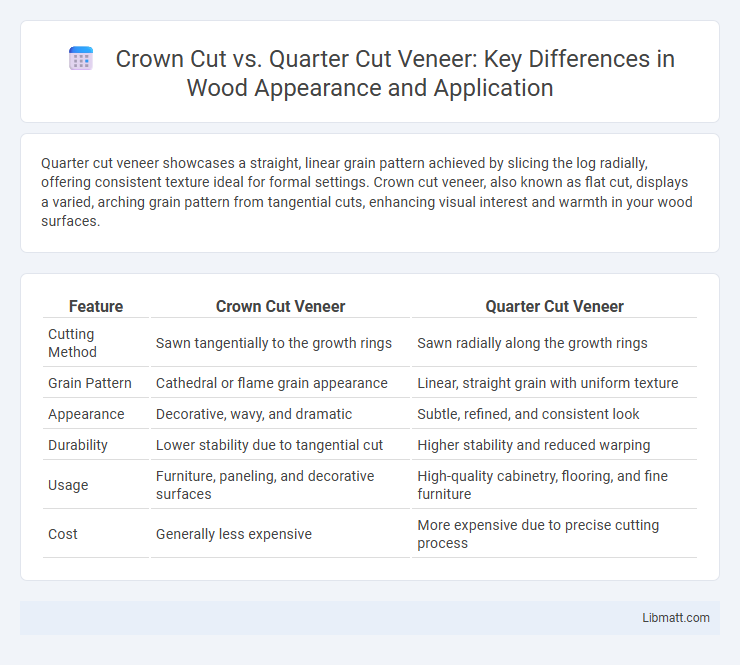Quarter cut veneer showcases a straight, linear grain pattern achieved by slicing the log radially, offering consistent texture ideal for formal settings. Crown cut veneer, also known as flat cut, displays a varied, arching grain pattern from tangential cuts, enhancing visual interest and warmth in your wood surfaces.
Table of Comparison
| Feature | Crown Cut Veneer | Quarter Cut Veneer |
|---|---|---|
| Cutting Method | Sawn tangentially to the growth rings | Sawn radially along the growth rings |
| Grain Pattern | Cathedral or flame grain appearance | Linear, straight grain with uniform texture |
| Appearance | Decorative, wavy, and dramatic | Subtle, refined, and consistent look |
| Durability | Lower stability due to tangential cut | Higher stability and reduced warping |
| Usage | Furniture, paneling, and decorative surfaces | High-quality cabinetry, flooring, and fine furniture |
| Cost | Generally less expensive | More expensive due to precise cutting process |
Introduction to Veneer Cutting Techniques
Crown cut and quarter cut are two primary veneer cutting techniques used to maximize the visual appeal of wood surfaces. Crown cut veneer, also known as plain slicing, reveals broad, cathedral grain patterns that enhance the natural beauty of hardwoods like oak and walnut. Quarter cut veneer, sliced radially from the log, produces straight, linear grain patterns that provide a more uniform and sophisticated look ideal for fine furniture and cabinetry.
What is Crown Cut Veneer?
Crown cut veneer is a wood slicing technique that produces a distinctive grain pattern characterized by broad, sweeping arches resembling a cathedral arch. This method involves slicing logs tangentially, parallel to the growth rings, to highlight the natural wood figure and create an aesthetically appealing surface. Crown cut veneers are commonly used in high-end furniture, cabinetry, and decorative paneling for their elegant and striking visual appeal.
What is Quarter Cut Veneer?
Quarter cut veneer is a wood veneer produced by slicing logs into quarters before cutting thin sheets, resulting in straight grain patterns and a more uniform appearance compared to crown cut veneer. This technique maximizes the use of less prominent wood sections, enhancing durability and reducing waste. Your choice of quarter cut veneer offers a clean, linear aesthetic ideal for modern furniture and architectural applications.
Visual Differences: Crown Cut vs Quarter Cut
Crown cut veneer displays a distinctive cathedral grain pattern with wide, sweeping arches, creating a more decorative and elaborate appearance. Quarter cut veneer features straight, linear grain lines with a tighter, more uniform texture, emphasizing subtle elegance and uniformity. These visual differences make crown cut veneers ideal for ornamental surfaces, while quarter cut veneers suit applications requiring a refined, consistent look.
Grain Patterns and Texture Comparison
Crown cut veneer displays a distinctive cathedral or flame-like grain pattern, creating a more decorative and varied surface ideal for aesthetic focal points. Quarter cut veneer features straight, tight, and consistent grain lines, producing a smoother texture that enhances uniformity and durability. Both cuts emphasize different wood characteristics, with crown cut providing visual interest and quarter cut maximizing structural stability and subtle elegance.
Applications and Best Uses
Crown cut veneer showcases a broad, natural grain pattern ideal for decorative surfaces such as furniture, paneling, and cabinetry where visual appeal is paramount. Quarter cut veneer features a straighter, more uniform grain, making it suitable for applications requiring durability and consistent aesthetics, including flooring, doors, and architectural millwork. Selecting between crown cut and quarter cut veneer depends on desired grain appearance and the product's structural requirements in interior design projects.
Durability and Performance Factors
Crown cut veneer offers superior visual appeal with broad, arching grain patterns but typically exhibits less dimensional stability compared to quarter cut veneer, which is known for its consistent linear grain and enhanced resistance to warping and cupping. Quarter cut veneer demonstrates greater durability under fluctuating humidity and temperature conditions, making it ideal for high-performance applications requiring long-term structural integrity. The performance factors of quarter cut veneers include higher resistance to abrasion and swelling, ensuring longevity in both residential and commercial environments.
Cost Implications of Each Cut
Crown cut veneer generally involves higher labor and material costs due to its complex slicing from the log's curved surface, producing wider and more decorative grain patterns. Quarter cut veneer is more cost-efficient as it yields straighter grain and maximizes log utilization, minimizing waste. Choosing between the two influences overall project budget, with crown cut veneer often preferred for premium aesthetics despite its higher price.
Sustainability and Wood Yield
Quarter cut veneer offers higher sustainability due to more efficient wood utilization, producing straighter grain patterns with less waste compared to crown cut veneer. Crown cut veneer yields more decorative, curved grain patterns but results in lower wood yield and increased material waste during production. Your choice between these cuts impacts both environmental footprint and the economical use of raw timber resources.
Choosing the Right Veneer Cut for Your Project
Selecting between crown cut and quarter cut veneer depends on the desired grain pattern and application. Crown cut veneer, with its cathedral-like grain, is ideal for decorative surfaces, adding warmth and visual interest. Quarter cut veneer offers a straighter, more uniform grain, providing durability and elegance suitable for furniture and flooring projects.
Crown cut vs Quarter cut veneer Infographic

 libmatt.com
libmatt.com